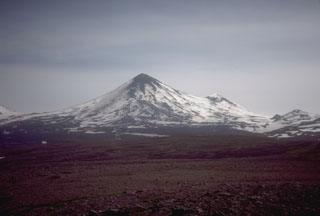Report on Pavlof (United States) — January 1977
Natural Science Event Bulletin, vol. 2, no. 1 (January 1977)
Managing Editor: David Squires.
Pavlof (United States) Decreased seismicity; small steam emissions
Please cite this report as:
Global Volcanism Program, 1977. Report on Pavlof (United States) (Squires, D., ed.). Natural Science Event Bulletin, 2:1. Smithsonian Institution. https://doi.org/10.5479/si.GVP.NSEB197701-312030
Pavlof
United States
55.417°N, 161.894°W; summit elev. 2493 m
All times are local (unless otherwise noted)
Seismic activity at Pavlof, characterized by [50-1,000] events/day August-November 1976, had declined to 10-15 events/day during a 2-day period in mid-December. During periods of high seismic activity, individual events frequently blended together, producing an effect similar, but not identical, to harmonic tremor (one frequency dominant). Approximately one earthquake/week (probably tectonic in origin) is locatable.
Due to poor weather conditions, visual observations of Pavlof were impossible during January. When visited on 21 December, Pavlof was emitting very small amounts of steam.
Geological Summary. The most active volcano of the Aleutian arc, Pavlof is a Holocene stratovolcano that was constructed along a line of vents extending NE from the Emmons Lake caldera. Pavlof and Pavlof Sister to the NE form a dramatic pair of symmetrical, glacier-covered stratovolcanoes that overlook Pavlof and Volcano bays. Little Pavlof is a smaller cone on the SW flank of Pavlof volcano, near the rim of Emmons Lake caldera. Unlike Pavlof Sister, eruptions have frequently been reported from Pavlof, typically Strombolian to Vulcanian explosive eruptions from the summit vents and occasional lava flows. The active vents lie near the summit on the north and east sides. The largest recorded eruption took place in 1911, at the end of a 5-year-long eruptive episode, when a fissure opened on the N flank, ejecting large blocks and issuing lava flows.
Information Contacts: J. Davies, LDGO; R. Dean, USAF, Cold Bay.

